The need to have strong control over the passwords used cannot be overemphasized these days when cybersecurity threats are constantly growing. The recent huge data breaches have revealed 16 billion login credentials, and this could be disastrous in some of the largest platforms, such as Microsoft, Apple, Facebook, and Google, which require holistic solutions that address password security issues.
In 2025, the digital environment will be a whole new challenge to people and companies. The urge to use or have the same password or even use weak but easy-to-remember credentials has never been high, with the average person having dozens of accounts online across different websites and services. However, this method exposes the users to the danger of identity theft, money misappropriation, and unauthorized access to sensitive personal and professional details.
The best solution to these problems has been shown to be the use of password management tools, where security and convenience balance is at optimal levels. These advanced tools not only create and store complicated and unique passwords on each account but also offer other security options like dark web or overflow, safe sharing possibilities, and integration of multi-factor verification.
Understanding Password Management Tools: The Foundation of Digital Security
Password management tools are the secure software programs where all passwords are stored, generated, and managed with one single master password. It is a secure digital vault that removes the need to remember numerous credentials, hence providing safeguarding for your data.
Most password managers employ encryption using zero-knowledge, which means not even the provider can reach your data. All the information gets encrypted at the local machine level and synced to safe servers so that no other person can decrypt the same.
It can be grouped into 3 main types: cloud-based (synced across devices), browser-based (simple autofill and storage), and offline and local (the most control options, no syncing). More advanced tools are also provided with similar functionality as AES-256 encryption, autogeneration of passwords, secure autofill, and encrypted note storage.
Essential Criteria for Selecting the Right Password Management Tools
When evaluating password management tools, security features should be your primary consideration. Look for the following:
1. Prioritize security features: The top priority should be placed on the security of the password managing tool. Find tools that are zero-knowledge encrypted so that even the provider cannot access the data. Two-factor and biometric signatures are introduced to cause additional protection.
2. Ensure cross-platform compatibility: Select a password manager that performs well on all your devices. The most promising have flexible synchronization with Windows, macOS, iOS, Android, and most browsers, so wherever you are, you can have access to your passwords.
3. Focus on user experience: A clean, user-friendly interface is key to regular use. The autofill, self-learning route, and the unwinding nature of a browser can enhance usability dramatically and minimize friction that is extremely important in day-to-day activities.
4. Consider pricing and value: Password managers come at different prices, with the free and the premium offerings. Evaluate your needs and affordability well; the price of good password security is minimal compared to the threat of its exploitation.
Top Password Management Tools for 2025
1. 1Password
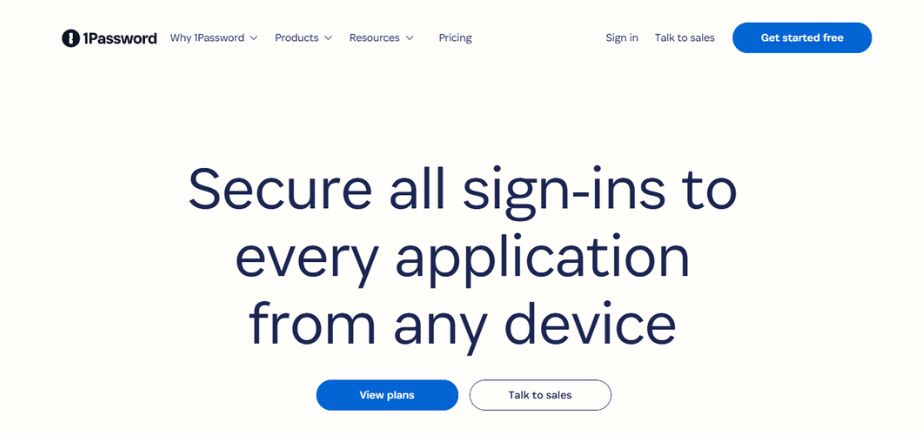
1Password is an exclusive password manager that has arguably the best user-friendly interface as well as high-security standards. It was designed in Canada and performs well both in a personal and business scenario with high-sharing features, travel mode, and overall administrative controls. This platform provides synchronization across all devices with military-level encryption and such additional security-oriented functionality as Watchtower to monitor the security.
Key Features:
- Travel Mode for temporary data removal
- Watchtower security monitoring
- Advanced sharing and team collaboration
- Comprehensive two-factor authentication
- Secure document storage
Pros:
- Exceptional user interface and experience
- Strong business and family features
Cons:
- Higher pricing compared to competitors
- No free tier available
Website:
1password.com
Pricing:
$2.99/month individual, $4.99/month family, $7.99/month business
2. Bitwarden
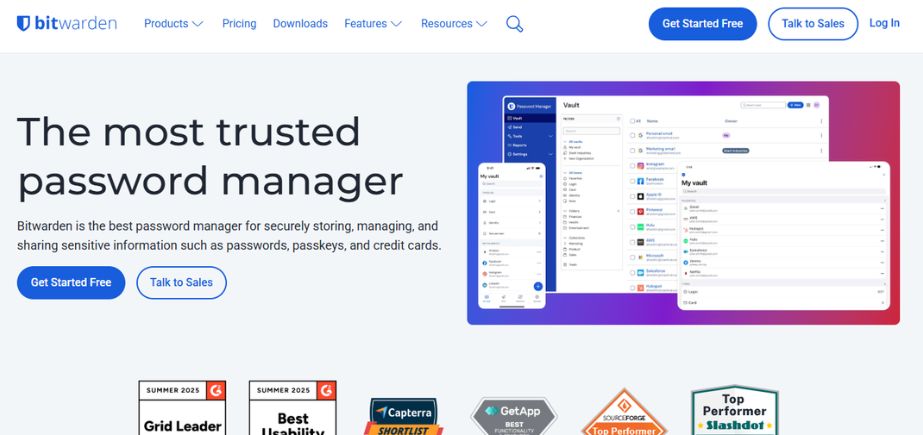
Bitwarden is one of the most popular password management tools that is transparent, cheap and does not sacrifice security. It stores unlimited passwords even at the free plan, supports military-grade encryption, and allows deploying instances; this makes it attractive to privacy-confident users and companies. Its adherence to accessibility and versatile range of functions would make the platform one of the best options in terms of rich security coverage at every price range.
Key Features:
- Open-source transparency
- Self-hosting capability
- Unlimited free password storage
- Advanced two-factor authentication
- Cross-platform synchronization
Pros:
- Generous free tier with unlimited passwords
- Complete transparency through open-source code
Cons:
- Interface less polished than premium competitors
- Limited customer support on free tier
Website:
bitwarden.com
Pricing:
Free tier available, Premium $10/year, Family $40/year
3. RoboForm
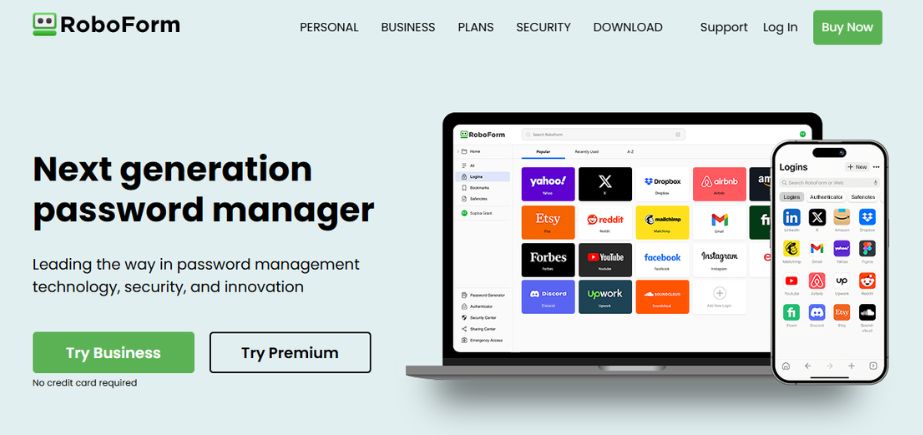
RoboForm has more than 20 years of experience in dealing with passwords and high standards of modern security so it is an ideal choice with an outstanding price of less than a dollar per month. The main strength of the platform is form-filling functionality, which is more than a mere password entry since it can fill whole web forms. The RoboForm is an easy and user-friendly solution to the challenges of password management with its bookmark-based organization and various options for password-free authentication at affordable prices.
Key Features:
- Advanced form-filling automation
- Bookmark-based password organization
- Passwordless authentication options
- Emergency access features
- Cross-platform synchronization
Pros:
- Extremely competitive pricing under $1/month
- Superior form-filling capabilities
Cons:
- Interface may feel dated compared to newer competitors
- Limited advanced business features
Website:
roboform.com
Pricing:
Free tier, Family $1.66/month, Business $2.66/user/month
4. Dashlane
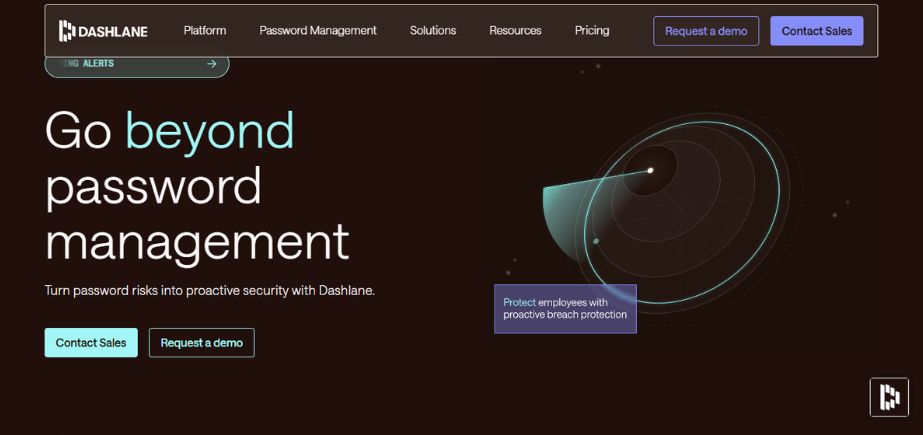
Dashlane is a top-end all-in-one digital security tool aimed beyond password manager to encompass VPN service, dark web monitoring, and identity theft insurance. The interface is very refined with detailed password health with automatic password change, where available, on common sites. Selling at a higher price than other products, Dashlane offers an ample number of features that are worth the price to users who want complete digital security.
Key Features:
- Built-in VPN service
- Dark web monitoring
- Identity theft insurance
- Automatic password changer
- Comprehensive security dashboard
Pros:
- All-in-one security solution with VPN and monitoring
- Polished user interface and experience
Cons:
- Higher pricing than most competitors
- Some features require premium subscription
Website:
dashlane.com
Pricing:
Free tier limited, Premium $4.99/month, Family $7.49/month
Also Read: Best Password Managers for iPhone
5. Keeper
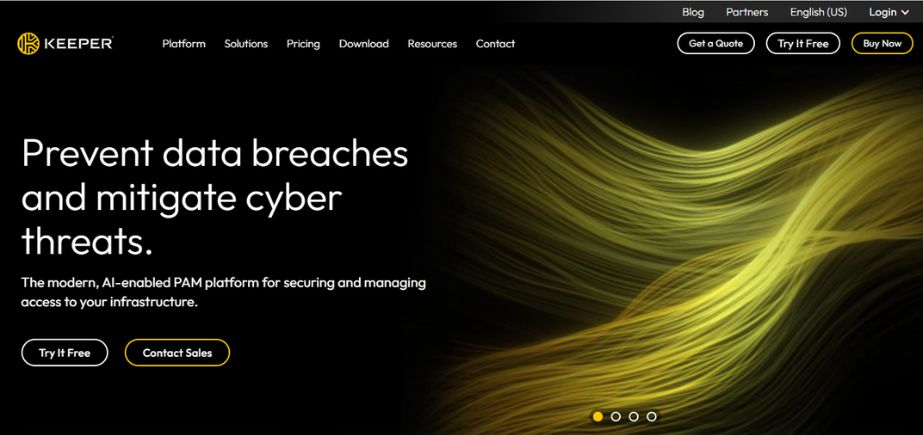
Keeper delivers enterprise security to both personal and business customers, including numerous levels of encryption, access control based on roles, and audit capabilities. Keeper is originally an enterprise solution providing BreachWatch dark web scanning, file storage in the cloud, and powerful administrative tools. Although the interface might seem complicated, on the other hand, this equates to more control and the freedom to customize security-sensitive individuals.
Key Features:
- Multiple encryption layers
- BreachWatch dark web monitoring
- Secure file storage capabilities
- Role-based access controls
- Comprehensive audit logs
Pros:
- Enterprise-grade security features
- Excellent file storage and sharing capabilities
Cons:
- Complex interface may overwhelm casual users
- Higher pricing reflects enterprise focus
Website:
keepersecurity.com
Pricing:
Personal plans start at $3.33/month with up to 100 GB storage
6. NordPass
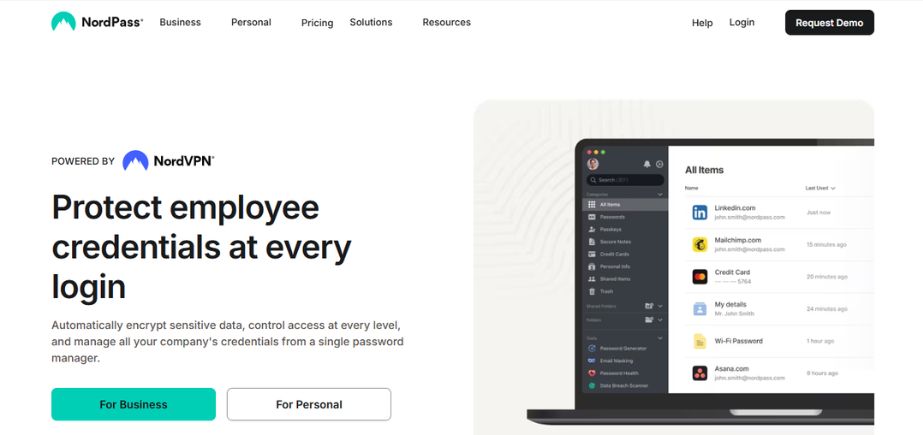
NordPass is a branch of the NordVPN team, using its experience in cybersecurity to provide a safe and comforting password-managing application. WordPress is the provider of competitive features at affordable rates; it has the XChaCha20 encryption, zero-knowledge architecture, a clear interface, zero-knowledge architecture, and a clean interface. Current releases have brought biometric login, standalone browser extensions, and improved security reporting as evidence of ongoing improvement and innovation.
Key Features:
- XChaCha20 advanced encryption
- Biometric authentication support
- Standalone browser extensions
- Security breach monitoring
- Clean, minimalistic interface
Pros:
- Backed by established cybersecurity company
- Competitive pricing with regular promotions
Cons:
- Newer to market with fewer advanced features
- Limited business and enterprise options
Website:
nordpass.com
Pricing:
Free; premium at $1.49/month; family at $2.69/month
7. Enpass
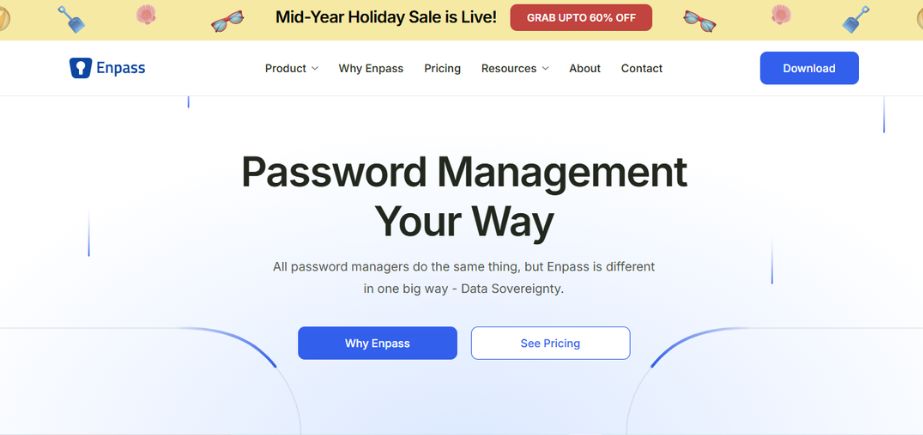
Enpass has a special feature of offline-first password management that keeps all data on the computers and phones of its users and allows synchronization with personal cloud storage services. Enpass is more attractive to users who want full access to their information since they have a one-time payment structure rather than a subscription-based model. It offers all-around import functionality, automatic backups, and audit abilities as it stores data locally instead of keeping it somewhere public.
Key Features:
- Offline-first local storage approach
- One-time purchase pricing model
- Personal cloud sync options (Dropbox, Google Drive)
- Comprehensive password import capabilities
- Automatic backup functionality
Pros:
- Complete data control with local storage
- One-time purchase avoids subscription fees
Cons:
- Synchronization requires separate cloud storage setup
- Limited customer support compared to subscription services
Website:
enpass.io
Pricing:
Individual at ₹86.56/month; family at ₹259.69; one-time plan at ₹7574.69
8. KeePassXC
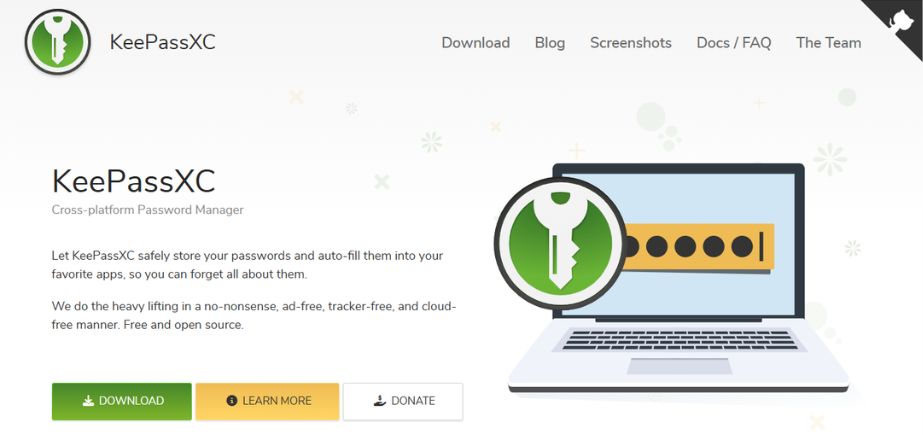
KeePassXC is the peak of open-source password management software, which combines end-to-end transparency and local control in a security professional and privacy-focused package. This is a completely offline solution dedicated to rock-solid password storage with military-grade encryption, supported by an active open-source community that will support it and allow constant enhancement of the security level. Although needing a bit more technical know-how on its part, KeePassXC provides unprecedented levels of control and customization due to its plugin system.
Key Features:
- Fully offline operation
- Complete open-source transparency
- Plugin architecture for customization
- Advanced encryption protocols
- Database format compatibility
Pros:
- Maximum security and privacy through offline operation
- Free and open-source with community support
Cons:
- Requires technical knowledge for setup and maintenance
- No cloud synchronization or mobile convenience features
Website:
keepassxc.org
Pricing:
Completely free and open-source
9. Zoho Vault
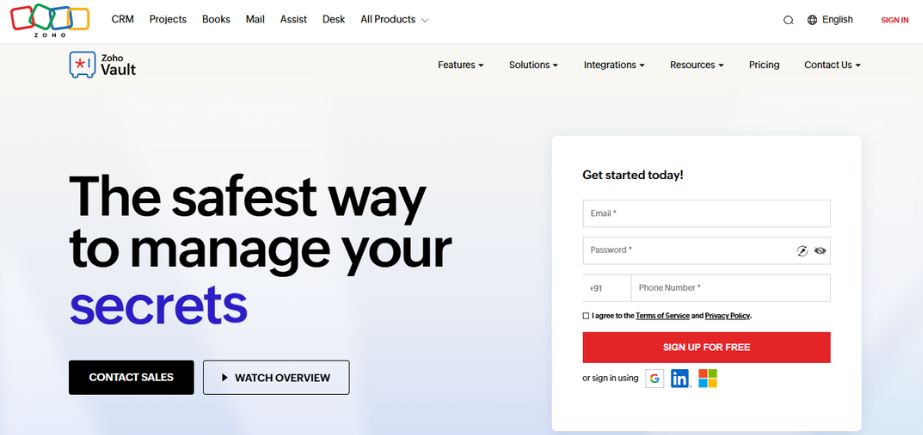
Zoho Vault is a password management application geared toward business use that ties into the rest of the Zoho line of productivity tools. It is designed for small to medium-sized companies, providing competitively priced single sign-on (SSO) and multi-factor authentication, as well as role-based access controls. Zoho Vault offers tremendous value to organizations that use products in the Zoho suite or need integrated business password management tools to benefit its team collaboration capabilities.
Key Features:
- Single Sign-On (SSO) integration
- Role-based access controls and user management
- Multi-factor authentication support
- Secure password sharing with teams
- Integration with Zoho business suite
Pros:
- Extremely affordable business pricing starting at $0.90 per user
- Seamless integration with existing Zoho ecosystem
Cons:
- Limited features for personal use compared to consumer-focused alternatives
- Interface may feel basic compared to premium competitors
Website:
zoho.com/vault
Pricing:
Free personal plan, Standard ₹60 per user per month, Professional ₹275 per user per month, Enterprise ₹480 per user per month (billed annually)
10. LogMeOnce
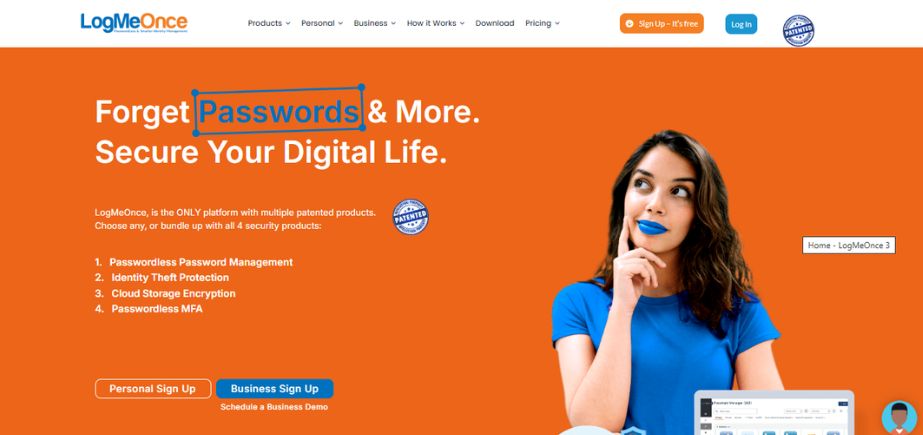
LogMeOnce presents itself as a complete password-free product that can be characterized by such novelties as facial recognition technology, anti-theft features, and patented login systems via QR code. LogMeOnce offers a twist on password management by allowing people to use all the security functions of their services, such as AES-256 encryption, password auditing, and various multifactor authentication methods in a single application. The developers have packed it with features but the interface can end up being overwhelming and it should therefore find its use among security-conscious users who favor complex features over simplicity.
Key Features:
- Patented passwordless QR code login
- Facial recognition authentication
- Anti-theft protection for devices
- Comprehensive password auditing tools
- Multiple two-factor authentication options
Pros:
- Extensive features with unlimited passwords and devices on free plan
- Innovative passwordless authentication methods
Cons:
- Mobile apps fail to automatically capture and save new login credentials
- Overwhelming number of tools and not-so-friendly interface
Website:
logmeonce.com
Pricing:
Free tier with unlimited passwords, Premium plans with advanced features and priority support
Business and Enterprise Considerations
Organizations face unique challenges when implementing password management solutions. Advanced-level password managers and enterprise-level password managers provide role-based access controls, audit logging to the level of password changes, and integration with an organization’s identity management systems.
The standards of security and audit capabilities may be determined by the requirements of compliance. Most password managers include functions, which support a wide range of regulations, such as SOC 2 compliance, compliance with the GDPR, and industry-specific standards.
Employee adoption and training are important during the enterprise implementation. Select solutions that provide detailed onboarding material and face continuous support in order to make use of the employees to use the new security practices.
The Future of Password Management Tools
The area of password management keeps changing dynamically, and new technologies and methods appear on a regular basis. Also popular as passwordless authentication are biometric verification and hardware tokens, which aim to replace the traditional password-based system.
Combined with the new technology, artificial intelligence and machine learning are likely to improve security monitoring and threat detection. These developments will probably bring about more advanced persona analysis of user accounts and also improve further identification of security threats.
The current work to standardize authentication processes on web applications like WebAuthn and FIDO2 protocols leads to a possibility of password managers becoming even more prominent in the arena of digital protection and legitimization, allowing authentication on an ever-wider variety of devices and platforms.
Making Your Decision
Choosing password management tools is something that you should pay particular attention to your requirements, technical capabilities, and budget. A single user might worry more about simplicity and affordability, whereas a business might need the advanced open-source features and management controls.
You may want to consider going the free route or having a trial period to determine how a password manager will fit into your everyday operations. User experience and ease of use should carry heavy weight in your decision since you need a password manager that you would continue to use properly and regularly.
Keep in mind that switching to a password manager is an investment in your long-term digital safety. Setting up and migrating your current passwords may take some initial work but will be worth it eventually as it makes your work environment much safer and more convenient to manage.
Conclusion
In this era of constant risk of cyberattacks, the need to have a powerful password manager has become more imperative than before. The password reuse, poor passwords, and security habits risks are only increasing as our relationship with the digital becomes more complicated.
The password management tools discussed in this guide are the latest representatives of the technology in digital security tools. Besides deciding on the enterprise-centric solution of Keeper, the open-source transparency of Bitwarden, or the end user-friendly design of 1Password, each of these options will vastly enhance your security vis-a-vis manual management of your passwords. The reward of the purchase of a good password manager is experienced immediately when the convenience of it is felt and cumulatively as time goes by when the safety of it is experienced.
Make a change now and introduce a password management tool that is satisfactory to you. And your future self will forgive you for having made this important step toward overall digital security. It is not a matter of whether or not you should have a password manager, but what password manager is going to work best towards your specific needs, as well as offer the security and convenience you require in our ever-more digital world.
FAQs
What is a password manager?
A password manager is a piece of software that collects and keeps your passwords in an encrypted locker. It assists you in creating, accessing, and auto-filling complicated passwords instead of keeping them in mind.
Are password managers secure?
Yes, the majority of trusted password managers have strong encryption (such as AES-256), and a zero-knowledge system, which implies that even a provider can not access your data. They are also in favor of multi-factor authentication to increase security.
What is the functionality of password managers?
Password managers keep your login details encrypted, but as you have to access them you can use a master password or biometric password to access them. Most of them also have such features as password generation, autofill, and secure note storage among others.
Is it possible to use a password manager in more than one device?
Yes, the majority of contemporary password managers have the cross-platform synchronization feature which means you can view your passwords on desktops, laptops, smart devices, and tablets.
What would I do in case I forget my master password?
Other password managers provide account rescues such as backup code or biometrics rescue. But a lot of them perform zero-knowledge encryption, in case you have no recovery options, your information might still be unrecoverable.

